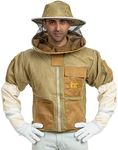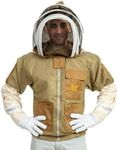Buying Guide for the Best Beekeeper Suits
Choosing the right beekeeper suit is essential for both safety and comfort while working with bees. A good suit protects you from stings, allows you to move freely, and keeps you cool during long hours in the apiary. When shopping for a beekeeper suit, it's important to consider the material, fit, ventilation, visibility, and ease of use. Understanding these key features will help you select a suit that matches your needs and makes beekeeping a safer and more enjoyable experience.MaterialThe material of a beekeeper suit determines its durability, weight, and level of protection. Common materials include cotton, polyester, and blends. Cotton suits are breathable and comfortable but can be heavier and less durable. Polyester and synthetic blends are lighter and often more durable, but may not be as breathable. Some suits use a three-layer mesh for extra ventilation and sting resistance. If you work in hot climates or for long periods, prioritize breathable materials. For maximum protection, look for thicker or layered fabrics.
VentilationVentilation refers to how well the suit allows air to flow, keeping you cool. Some suits have mesh panels or are made entirely from ventilated fabric. Non-ventilated suits can get hot quickly, especially in warm weather. Ventilated suits are ideal for beekeepers who work in hot climates or tend to overheat easily. If you only work with bees for short periods or in cooler weather, standard suits may suffice.
Fit and SizingThe fit of your suit affects both comfort and protection. A suit that's too tight can restrict movement and may leave gaps where bees can enter, while a suit that's too loose can be cumbersome. Most suits come in a range of sizes, and some offer adjustable features like elastic cuffs or waistbands. When choosing a size, consider wearing clothes underneath and ensure the suit allows you to move freely without being baggy. Try to find a suit that fits comfortably and covers your body completely.
Veil Type and VisibilityThe veil is the protective head covering that keeps bees away from your face and neck. There are several types, including round, fencing, and square veils. Round veils offer good visibility and airflow, while fencing veils are more compact and may be easier to store. The mesh should be fine enough to prevent bees from getting through but not so dense that it impairs your vision. Choose a veil that feels comfortable, provides clear visibility, and attaches securely to the suit.
Ease of UseEase of use includes features like zippers, pockets, and how easy it is to put on or take off the suit. Look for suits with sturdy zippers, especially around the veil and main body, as these areas are most used. Pockets can be handy for carrying tools. Thumb loops and elastic at the wrists and ankles help keep the suit in place. If you plan to suit up frequently or quickly, prioritize suits with simple, reliable closures and easy access.
Washability and MaintenanceBeekeeper suits can get dirty quickly, so it's important to consider how easy they are to clean. Some suits are machine washable, while others may require hand washing. Lighter colors show stains more easily but also help you spot bees before removing the suit. If you want a low-maintenance option, look for suits that are easy to wash and dry, and check if the veil is detachable for separate cleaning.
















